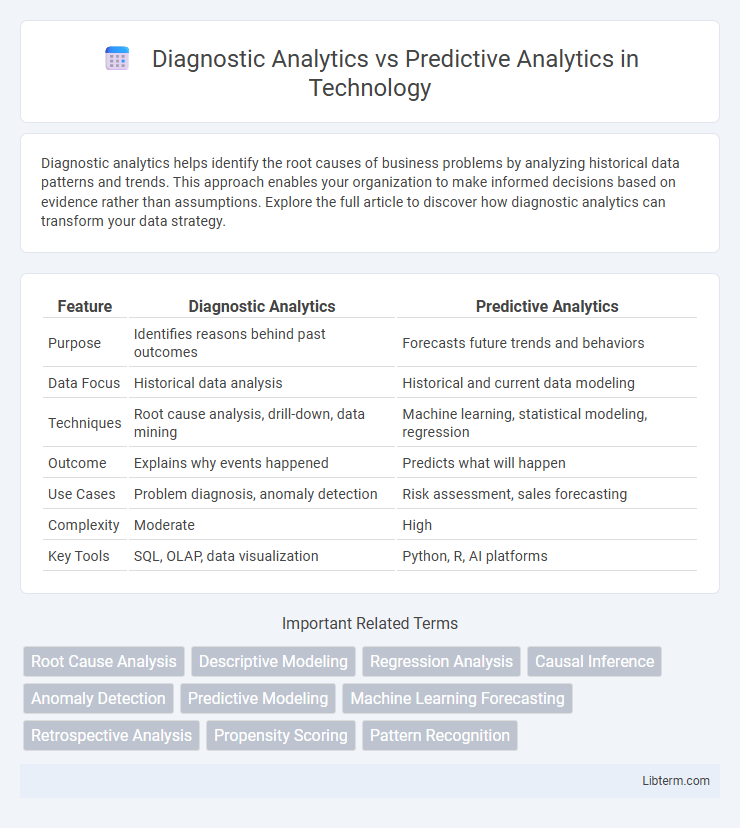Diagnostic analytics helps identify the root causes of business problems by analyzing historical data patterns and trends. This approach enables your organization to make informed decisions based on evidence rather than assumptions. Explore the full article to discover how diagnostic analytics can transform your data strategy.
Table of Comparison
| Feature | Diagnostic Analytics | Predictive Analytics |
|---|---|---|
| Purpose | Identifies reasons behind past outcomes | Forecasts future trends and behaviors |
| Data Focus | Historical data analysis | Historical and current data modeling |
| Techniques | Root cause analysis, drill-down, data mining | Machine learning, statistical modeling, regression |
| Outcome | Explains why events happened | Predicts what will happen |
| Use Cases | Problem diagnosis, anomaly detection | Risk assessment, sales forecasting |
| Complexity | Moderate | High |
| Key Tools | SQL, OLAP, data visualization | Python, R, AI platforms |
Understanding Diagnostic Analytics
Diagnostic analytics delves into historical data to identify the root causes behind past outcomes, utilizing techniques such as data mining, correlation analysis, and drill-down methods. It emphasizes understanding patterns and anomalies by dissecting transactional data, event logs, and customer feedback to uncover underlying issues. This form of analytics is crucial for improving decision-making processes by explaining why specific events occurred, enabling organizations to optimize performance and address problems effectively.
What Is Predictive Analytics?
Predictive analytics uses statistical algorithms, machine learning techniques, and historical data to forecast future outcomes and trends. It enables businesses to identify potential risks, opportunities, and customer behaviors by analyzing patterns and predicting likely scenarios. This approach drives proactive decision-making by transforming data into actionable insights for future planning.
Key Differences Between Diagnostic and Predictive Analytics
Diagnostic analytics focuses on understanding the causes behind past events by analyzing historical data patterns and identifying anomalies or correlations. Predictive analytics uses statistical models and machine learning algorithms to forecast future outcomes based on past and current data trends. Key differences include diagnostic analytics' retrospective approach to uncover reasons for past performance, whereas predictive analytics employs forward-looking techniques to anticipate potential scenarios and inform decision-making.
Core Objectives: Diagnostic vs Predictive Approaches
Diagnostic analytics centers on identifying the root causes of past events by analyzing historical data patterns and correlations, enabling businesses to understand why certain outcomes occurred. Predictive analytics leverages statistical models and machine learning algorithms to forecast future trends, behaviors, and potential risks based on historical and real-time data. The core objective of diagnostic analytics is explanation and insight, whereas predictive analytics aims at anticipation and decision support.
Tools and Techniques Used in Diagnostic Analytics
Diagnostic analytics employs tools like root cause analysis, data mining, and drill-down techniques to identify patterns and anomalies in historical data. Techniques such as correlation analysis, regression analysis, and data visualization using platforms like Tableau or Power BI enable detailed examination of data relationships and contributing factors. These methods help organizations uncover underlying causes of past events, facilitating informed decision-making and problem-solving.
Methods and Models in Predictive Analytics
Predictive analytics utilizes statistical models, machine learning algorithms, and data mining techniques to forecast future outcomes based on historical data patterns. Common methods include regression analysis, decision trees, neural networks, and time series forecasting, which analyze variables and detect trends to predict potential events. These models rely heavily on large datasets and computational power to improve accuracy and enable proactive decision-making.
Use Cases: Diagnostic Analytics Across Industries
Diagnostic analytics is crucial for identifying the root causes of past performance issues across various industries, such as pinpointing manufacturing defects in production lines, analyzing customer churn patterns in telecommunications, and uncovering factors behind financial discrepancies in banking. In healthcare, diagnostic analytics helps detect the underlying reasons for patient readmissions and treatment failures, while in retail, it is used to understand sales slumps and inventory shortages. These insights enable organizations to implement targeted improvements by focusing on historical data patterns, ensuring accurate problem-solving and operational efficiency.
Applications of Predictive Analytics in Business
Predictive analytics leverages historical data, statistical algorithms, and machine learning to forecast future trends, enabling businesses to optimize marketing campaigns, manage inventory, and enhance risk management. Applications include customer segmentation for personalized marketing, sales forecasting to improve supply chain decisions, and fraud detection in financial services. By anticipating customer behavior and market changes, predictive analytics drives proactive strategy and competitive advantage in various industries.
Choosing the Right Analytics Approach for Your Organization
Diagnostic analytics uncovers the root causes of past performance issues using techniques such as data mining, drill-down, and correlation analysis, essential for organizations aiming to understand historical data patterns. Predictive analytics leverages machine learning algorithms and statistical models to forecast future trends and behaviors, enabling proactive decision-making in dynamic business environments. Selecting the right analytics approach depends on organizational goals, data maturity, and the need for either retrospective insights or forward-looking predictions to drive strategic actions.
Future Trends in Diagnostic and Predictive Analytics
Emerging trends in diagnostic analytics emphasize real-time data integration and AI-driven root cause analysis to enhance decision-making accuracy. Predictive analytics is advancing with machine learning models that improve forecast precision and incorporate behavioral data for personalized predictions. Combined, these future trends drive more proactive strategies across industries, leveraging big data and automated insights for optimized business outcomes.
Diagnostic Analytics Infographic

 libterm.com
libterm.com